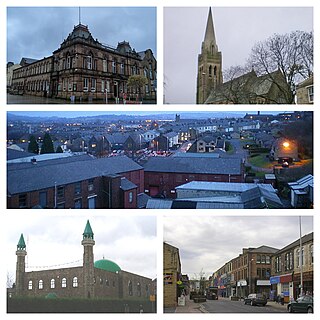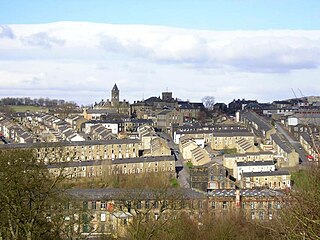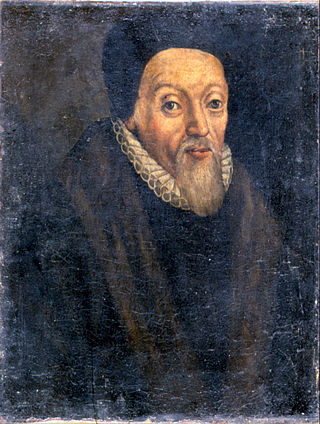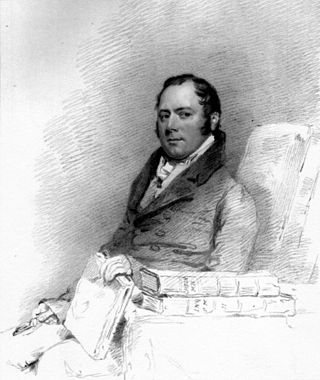
Higham is a village in the Borough of Pendle in Lancashire, England, south of Pendle Hill. The civil parish is named Higham with West Close Booth. The village is 2 miles (3 km) north-east of Padiham and about 4 miles (6 km) south-west of Nelson along the A6068 road.

Nelson is a town and civil parish in the Borough of Pendle in Lancashire, England, with a population of 29,135 in 2011. It is 4 miles (6.4 km) north of Burnley and 3 miles south-west of Colne.

Colne is a market town and civil parish in the Borough of Pendle in Lancashire, England. Located three miles northeast of Nelson, six miles northeast of Burnley, 25 mi (40 km) east of Preston and 30 mi (50 km) west of Leeds.

Alexander Nowell was an Anglican priest and theologian. He served as Dean of St Paul's during much of Elizabeth I's reign, and is now remembered for his catechisms, written in Latin.
Robert Gillow (1704–1772) was an English furniture manufacturer, who founded Gillow & Co.

Barrowford is a large village and civil parish in the Pendle district of Lancashire, England. It is situated to the north of Nelson on the other side of the M65 motorway, and forms part of the Nelson conurbation. It also comprises the area of Lowerford. The parish has a population of 6,171. The community is located near the Forest of Bowland, an Area of Outstanding Natural Beauty while the Borough of Pendle is at the southern edge of the Yorkshire Dales.

Bowland Forest Low is a civil parish in the Ribble Valley district of Lancashire, England, covering some 5,500 acres (22 km2) of the Forest of Bowland. According to the 2001 census, the parish had a population of 168, falling to 160 at the 2011 Census. The parish includes the hamlets of Whitewell and Cow Ark. From northwards clockwise, it borders the civil parishes of Newton, Bashall Eaves, Aighton, Bailey and Chaigley, Bowland-with-Leagram and Bowland Forest High. Before 1974, it formed part of Bowland Rural District in the West Riding of Yorkshire.

George Ormerod was an English antiquary and historian. Among his writings was a major county history of Cheshire, in North West England.

Laneshawbridge is a village and civil parish in the Borough of Pendle in England. The population of the civil parish at the 2011 census was 918. It is to the east of Colne in Lancashire and is the easternmost settlement in Lancashire on the main road route, before the North Yorkshire border.
In Old English law, a Bowbearer was an under-officer of the forest who looked after all manner of trespass on vert or venison, and who attached, or caused to be attached, the offenders, in the feudal Court of Attachment.
The Weld family are a cadet branch, arisen in 1843, of the English Welds of Lulworth. It is an old gentry family which claims descent from Eadric the Wild and is related to other Weld branches in several parts of the United Kingdom, notably from Willey, Shropshire and others in the Antipodes and America. A notable early Weld was William de Welde, High Sheriff of London in 1352, whose progeny moved in and out of obscurity.
John Parker was an English politician who was Member of Parliament (MP) for Clitheroe from 1780 to 1782 and Honorary Bowbearer of the Forest of Bowland, Lancashire.

Thomas Lister Parker was an English antiquary, landowner, Trumpeter to the Queen and Honorary Bowbearer of the Forest of Bowland, Lancashire.

Browsholme Hall is a privately owned Tudor house in the parish of Bowland Forest Low in the borough of Ribble Valley, Lancashire, England. It is claimed to be the oldest surviving family home in Lancashire. Since 1954, it has been designated a Grade I listed building by English Heritage.

Malkin Tower was the home of Elizabeth Southerns, also known as Demdike, and her granddaughter Alizon Device, two of the chief protagonists in the Lancashire witch trials of 1612.

The Waller family was a Kentish family, of Groombridge Place, that migrated to Hertfordshire and Buckinghamshire in the 14th or 16th century, and then to Gloucestershire, and, for a generation, North Yorkshire.
John Tarleton (1718–1773) was an English ship-owner and slave-trader, and Mayor of Liverpool in 1764.
John William Robinson Parker was a British soldier, antiquarian, owner of Browsholme Hall and Honorary Bowbearer of the Forest of Bowland, Lancashire.

Elizabeth Shackleton born Elizabeth Parker (1726–1781) was an English diarist. She was the only daughter of her father who inherited an estate in Yorkshire. She made a disappointing first marriage and a disastrous second. She is remembered for her diaries and letters which her family preserved. The diaries were the basis of an award-winning book about "Women's Lives in Georgian England" in 1998.
Robert Redmayne Parker is a British rural business adviser, land manager, and ceremonial officer. He worked with the Ministry of Agriculture, Fisheries and Food, prior to its merger into the Department for Environment, Food and Rural Affairs, and for the Country Land and Business Association. Since 1975, he has been the owner of Browsholme Hall, his family seat in Bowland Forest Low. In 2010, Parker was appointed as Bowbearer of the Forest of Bowland by William Bowland, 16th Lord of Bowland, becoming the first bowbearer of Bowland in almost one hundred and fifty years.














